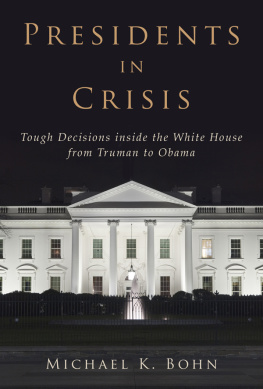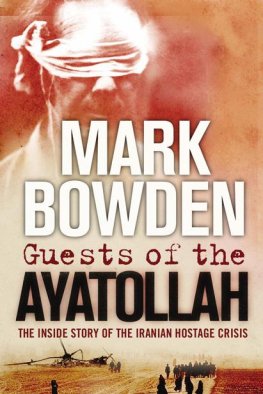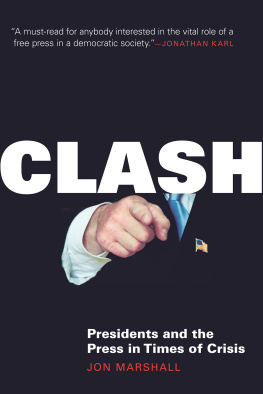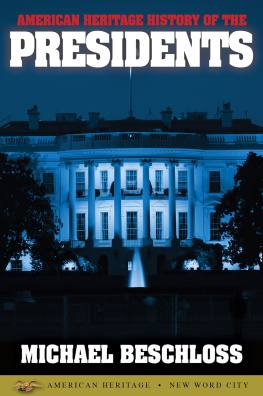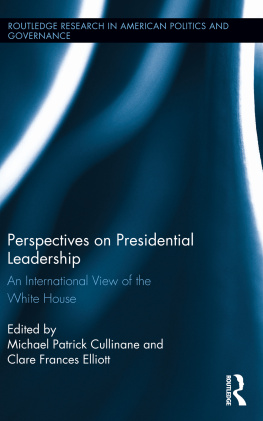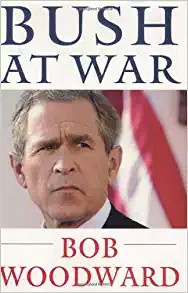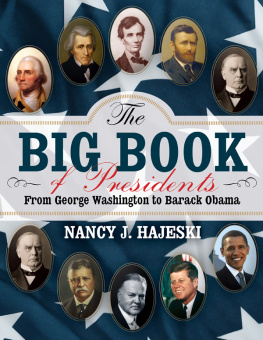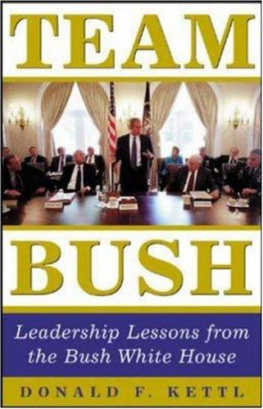Also by Michael K. Bohn:
Nerve Center: Inside the White House Situation Room
The Achille Lauro Hijacking: Lessons in the Politics and Prejudice of Terrorism
Money Golf: 600 Years of Bettin on Birdies
Heroes & Ballyhoo: How the Golden Age of the 1920s Transformed American Sports
Mount Vernon Revisited, with Jessie Biele
Copyright 2015 by Michael K. Bohn
All rights reserved. No part of this book may be reproduced in any manner without the express written consent of the publisher, except in the case of brief excerpts in critical reviews or articles. All inquiries should be addressed to Arcade Publishing, 307 West 36th Street, 11th Floor, New York, NY 10018.
First Edition
Arcade Publishing books may be purchased in bulk at special discounts for sales promotion, corporate gifts, fund-raising, or educational purposes. Special editions can also be created to specifications. For details, contact the Special Sales Department, Arcade Publishing, 307 West 36th Street, 11th Floor, New York, NY 10018 or .
Arcade Publishing is a registered trademark of Skyhorse Publishing, Inc., a Delaware corporation.
Visit our website at www.arcadepub.com.
Visit the authors site at www.bohnbooks.com.
10 9 8 7 6 5 4 3 2 1
Library of Congress Cataloging-in-Publication Data
Bohn, Michael K.
Presidents in crisis : tough decisions inside the White House from Truman to Obama / Michael K Bohn. First Edition.
pages cm
ISBN 978-1-62872-431-8 (hardback) ISBN 978-1-62872-475-2 (Ebook)
1. PresidentsUnited StatesDecision makingCase studies. 2. United StatesForeign relations19451989Case studies. 3. United StatesForeign relations1989Case studies. 4. Political leadershipUnited StatesCase studies. 5. Executive powerUnited StatesCase studies. I. Title.
E840.B647 2015
327.73dc23 2014038861
Cover design by Brian Peterson
Cover photo credit: Shutterstock
Printed in the United States of America
To my wife Elin in thanks for her forty-two years of love and support
CONTENTS
LIST OF MAPS AND CHARTS
Introduction
Chart for Grading Crisis Management
PREFACE
O nly a few hundred people alive today understand the difficulties facing an American president during an unanticipated international crisisthe presidents themselves and their closest advisers. Luckily for me, my experiences as the director of the White House Situation Room enabled me to at least recognize their challenges and reach some of them for interviews. However, as participants memories dim with passing time, I had to turn to written accounts, including the minutes of key decision-making meetings, or in some cases audio tape transcripts. Memoirs from presidents and their advisers were crucial sources, but my West Wing knowledge helped me scrub away any remaining image polish from self-serving accounts. In several instances, advisers told conflicting stories about a crisis, and I took the common denominator from the different accounts. Recollections from National Security Council staff membersthe note takers in critical meetingswere important and usually objective, as were observations from the dozens of Situation Room staff members who have served since the facilitys 1961 creation. Presidential biographers provided keen insights into presidential character and personality, but I had to season some books with grains of salt. Information on President Obamas crisis decision making, at least beyond that parceled out to the news media by his team, was hard to find. Even third-party accounts of Obamas crisis management by reputable publicationsMichael Lewiss article in the October 2012 issue of Vanity Fair and David Remnicks January 2014 piece in The New Yorker , for examplewere carefully orchestrated and vetted by administration officials. Last, I had the advantage of writing a 2003 book, Nerve Center, Inside the White House Situation Room , and the information I gathered for it from former presidents and national security advisers helped with this project.
Two developments prompted me to consider writing a second book about presidential crisis management. First was the opportunity to write individual newspaper stories about several of the crises in this book. I detailed two of the most dangerous situations for McClatchy Newspapers, a chain of twenty-nine dailies from the Miami Herald to the Anchorage Daily News . In 2011, using firsthand accounts from those involved, I re-created what happened on September 11, 2001, in the White House Situation Room and aboard Air Force One with President George W. Bush. The following year, the fiftieth anniversary of the 1962 Cuban Missile Crisis, I took McClatchy readers into John Kennedys tense White House meetings. I wrote a third piece in 2013 for the Washington Post magazine about the Washington-Moscow Hot Line, a crisis-managing communications tool that arose from the Cuban Missile Crisis. The Hot Line figured in several emergency situations after its installation in 1963. Researching these stories inspired me to analyze other crises, some of which I had touched on in Nerve Center .
The second issue has been the enormous amounts of partisan and ill-informed second-guessing from the sidelines by critics of a sitting president during a crisis. The phenomenon has arisen during every presidency that I studied, starting with Trumans. President Obamas handling of the Arab Spring crises that began in early 2011 drew rancorous partisan reactions, for example, just as armchair quarterbacks blasted the two Bush presidents and Reagan. Politicians and partisan news media stars naturally exploit most everything to their own advantage, with some presidents even attempting to use a crisis to quiet critics and boost poll ratings. But putting aside election-year posturing, no one on the sidelines can possibly appreciate how hard it is to make sensible decisions when time is short and lives are at stake. The titles of two recent memoirs, whether you agree with the authors or not, reflect those circumstances Decision Points , by George W. Bush, and Hard Choices by Hillary Clinton.
I want to acknowledge the help people have given me during this project, starting with my literary agent, Julia Lord, and my TV/film agent Judy Coppage. Cal Barksdale provided keen insight and editing at Arcade, and Don McKeon and Vicki Chamblee helped superbly when I was drafting the book proposal. A number of others contributed ideas and thoughts along the way: The Washington Post s Jim Hoagland, Professors Mark Rozell and Jim Pfiffner at George Mason University, Professor Denise Bostdorff at Wooster College, Professor William Quandt at University of Virginia, Professor Stephen Wayne at Georgetown University, Professor Amos Kiewe at Syracuse University, and James Kitfield at the Center for the Study of the Presidency & Congress.
Photo archivists at several presidential libraries helped greatly: Pauline Testerman, Truman; Kathy Struss, Eisenhower; Margaret Harman, Johnson; Jon Fletcher, Nixon; Polly Nodine, Carter; Michael Pinckney, Reagan; Mary Finch, Bush 41; Herbert Ragan, Clinton; Sarah Barca, Bush 43. Thanks also to Lisa Crunk at the US Naval History and Heritage Command, and the staff in the White House Photo Office.
September 15, 2014, was the cutoff date for this books assessment of President Obamas handling of the Syrian civil war, as well as the rise of the Islamic State and its control of areas of Syria and Iraq. The fluid nature of the confrontation between Russia and Ukraine at time of writing inhibited an analysis of Obamas reaction to that crisis.

